Original URL: https://www.theregister.com/2007/12/10/review_nvidia_8800_gts/
Nvidia G92-based GeForce 8800 GTS 512MB
The 8800 GT and then some
Posted in Channel, 10th December 2007 11:57 GMT
Review The GeForce 8800 GT slipped into Nvidia’s line-up towards the top of the range by offering similar performance to the existing 8800 GTS with 320MB of memory. This was achieved with an updated version of the 'G80' chip called 'G92', which moved the fabrication process to 65nm, changed the memory controller, raised the core speed and increased the number of unified shaders - or Stream Processors.
Although the 8800 GT performed in a similar way to the 8800 GTS it used a different technical approach and employed a different design. Where 8800 GTS and GTX are double-slot designs that blow cooling air over a hefty heatsink and out through a vented bracket at the back of the case, the new GT has a single-slot form-factor and keeps the air inside the case of your PC.
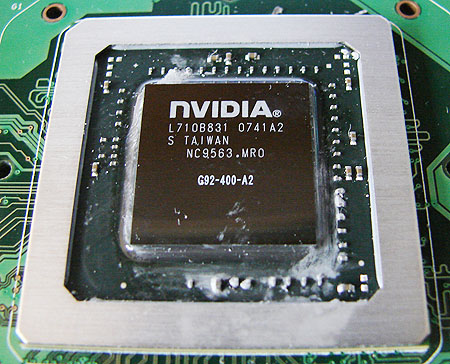
Nvidia's GeForce 8800 GTS: the G92 version
As we mentioned in our review, the GT gets hot to the touch, and we’ve recently heard a rumour that explains this situation. Nvidia was determined that the new GT would beat AMD’s equally new ATI Radeon HD 3870 so it raised the core and memory speeds as far as it dared and then set the fan speed to the point where it would just about keep the GT cool. The result is an impressive level of performance from a quiet, slender graphics card at a very keen price. The 8800 GT looks like a natural to replace the existing 8800 GTS over the next few months.
Which makes Nvidia’s new 8800 GTS something of a puzzle. For one thing, there’s the name. There is only one GT, so it’s clear that you’re getting a G92 chip. But the new GTS sits alongside existing GTS models that use the G80 chip. The safest way to tell them apart is that G80 cards have either 320MB or 640MB of memory while the G92 version comes with 512MB of GDDR 3. And a 256MB model is coming soon to further muddy the waters.
The technical differences between the new GTS and the GT are very slight and come down to clock speeds as they have the same amount of memory, the same memory controller and - according to most card suppliers - they each have 112 Stream Processors.
A basic 8800 GT has a core speed of 600MHz and memory that runs at an effective speed of 1800MHz. The speed of the Stream Processors is two and a half times that of the core speed so in this case the Shader speed is 1500MHz. Factory-overclocked 8800 GT models such as the MSI NX8800GT-T2D512E that we previously reviewed and which is acting as a comparison for the GTS runs at 660MHz and 1900MHz, and was happy to overclock a bit more to 700MHz and 2040MHz, which is about 15 per cent higher than the reference GT figures.
3DMark 06 Results
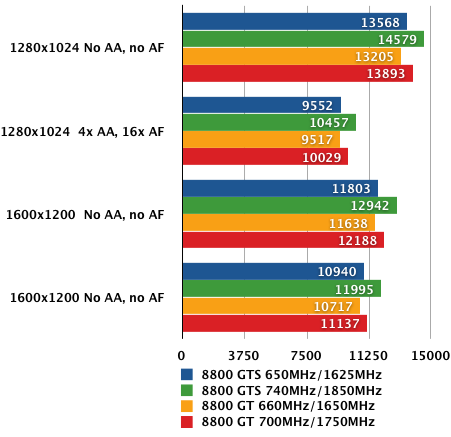
Longer bars are better
For comparison, the new GTS has a core speed of 650MHz and memory that runs at 1950MHz, so out of the box it’s a touch slower than the speeds we achieved with an overclocked MSI GT. We also overclocked the GTS and it ran at 740MHz and 2100MHz, so the new GTS is indeed faster than a GT, to the tune of five per cent.
Crysis Results
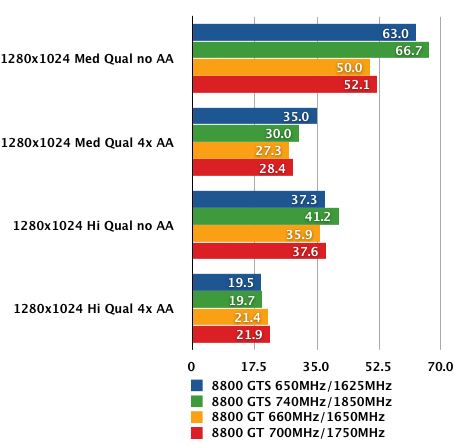
Frames per second
Longer bars are better
So how much does this sliver of extra performance cost? This is where things get a bit tricky as graphics card pricing is incredibly fluid, but a GT is priced between £175 and £199 while the new GTS will sell for around £229. This prices the GTS above the GT but somewhat lower than the current 640MB GTS, which is £259.
FEAR: Extraction Point Results
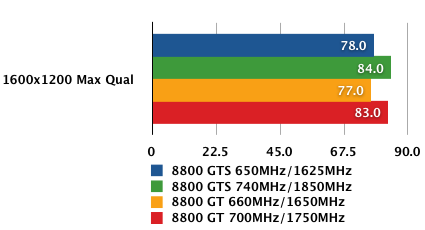
Frames per second
Longer bars are better
The other difference between the GT and GTS is the form-factor and the cooling package. As mentioned, the GT is a single slot-design while the GTS is a double-slot card that exhausts through a vented bracket. Strip the coolers off both cards and they look amazingly similar although the taller bracket on the GTS does give a clue.
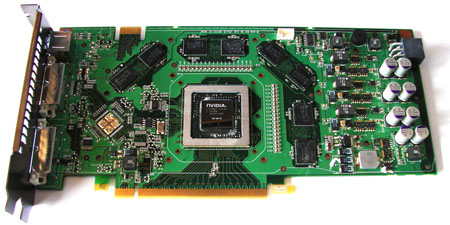
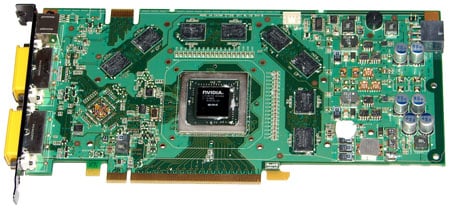
Fanless: The GTS (top) and MSI's NX8800GT
In many respects, the cooler on the new GTS is very similar to the existing GTS. However, there's a visual difference as the fan unit is mounted at an angle, as you can see in this photo:
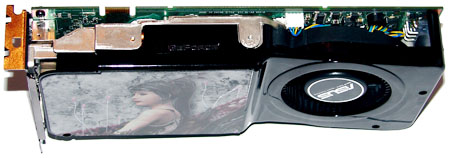
The angle-mounted fan
The difference between the two cooling packages becomes clear when the two graphics cards are working hard. The MSI X38 Diamond motherboard that we used in testing comes with a PCI Express audio riser card that was initially placed in the slot next to the GTS and the result was that the casing of the cooler had a temperature of 60°C. The audio riser seemed to be restricting airflow so we moved it to a different slot to create an air gap and the temperature of the graphics card dropped to 54°C.
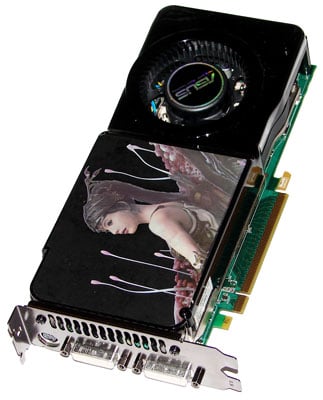
Cool runner
When we tested the MSI GT we found that the temperature of the casing was 73°C, so the single-slot design runs about 15°C hotter than the GTS and the hot air that it exhausts remains inside your case. Both cooling systems are very quiet and to all intents and purposes are silent.
One final point. World+Dog reckons the G92-based 8800 GTS contains the same number of Stream Processors as the G92-based 8800 GT: 112. However, utility GPU-Z told us the GTS has 128 for them. Given the performance similarities between the two GPUs, we'd expect them to contain the same number of Stream Processors.
Our sources tell us that, yes, the GTS does have 128 Stream Processors, which suggests a block of 16 has been disabled. Can they be re-activated? If so, that would certainly improve the GTS' value proposition.
Verdict
Nvidia's new GeForce 8800 GTS delivers a very small level of extra performance over and above the 8800 GT yet it costs significantly more. On the plus side the double-slot cooler is very efficient and quiet.